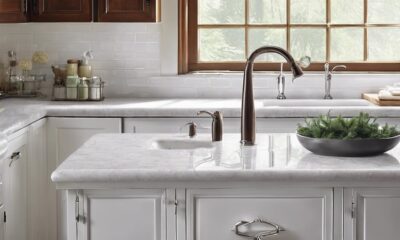Appliances
Choosing the Best Portable Air Purifiers for Allergies
2025

Are you tired of suffering from allergies caused by airborne pollutants? We understand the struggle and want to help you find the best solution.
In this guide, we will explore the world of portable air purifiers and provide you with the necessary knowledge to make an informed decision. From understanding the different types of purifiers to considering key features and filter types, we will cover it all.
We’ll even discuss user-friendly controls, maintenance requirements, and budget-friendly options. With our expertise, you can confidently choose the perfect portable air purifier to alleviate your allergies and improve your indoor air quality.
Let’s dive in and find the best solution for you!

Key Takeaways
- Look for a portable air purifier with a HEPA filter to effectively capture small particles like pet dander.
- Consider the coverage area of the air purifier to ensure it can adequately cover the size of the room or area.
- Choose a portable air purifier with a quiet operation to keep pets calm and comfortable.
- Consider filter types like HEPA filters, activated carbon filters, UV filters, and ionizers for allergy relief.
Types of Portable Air Purifiers
We will now explore the various types of portable air purifiers available in the market. When it comes to addressing specific needs such as pet allergies or eliminating smoke particles, there are specialized options to consider.
For pet owners, portable air purifiers designed specifically for pets can be a game-changer. These purifiers are equipped with advanced filtration systems that effectively capture pet dander, hair, and odors. They often feature HEPA filters, which are highly efficient at removing microscopic particles, ensuring clean and fresh air in your home.
On the other hand, portable air purifiers for smoke are designed to tackle the specific challenge of eliminating smoke particles and odors. These purifiers utilize activated carbon filters that are highly effective at trapping and neutralizing smoke particles and associated smells. They can significantly improve the air quality in homes affected by smoke from cigarettes, cooking, or wildfires.
When considering the different types of portable air purifiers, it’s important to evaluate their key features. These may include the size of the unit, the coverage area it can handle, the noise levels produced, and the energy efficiency rating. By understanding the specific needs of your living space and considering these key features, you can make an informed decision and choose the best portable air purifier that suits your needs.

Now, let’s dive deeper into these key features to consider.
Key Features to Consider
Continuing our exploration of portable air purifiers, let’s now delve into the key features to consider when choosing the best one for your needs.
When it comes to combating pet dander, there are a few essential features to look for in a portable air purifier. Firstly, consider the air purifier’s filtration system. Look for a purifier that utilizes a high-efficiency particulate air (HEPA) filter, as it’s capable of capturing small particles like pet dander.
Secondly, consider the purifier’s coverage area. Ensure that the purifier can adequately cover the size of the room or area where your pet spends most of its time.

Lastly, consider the noise level of the purifier. Some pets may be sensitive to loud noises, so choosing a purifier with a quiet operation can help keep them calm and comfortable.
For those dealing with smoke-related allergies, different features become important. Look for a portable air purifier that has an activated carbon filter. Activated carbon is highly effective in removing smoke particles and odors from the air.
Additionally, consider the air purifier’s CADR rating (Clean Air Delivery Rate) for smoke. A higher CADR rating means the purifier can remove smoke particles from the air at a faster rate.
Lastly, check if the purifier has a smoke sensor or indicator. This feature can provide real-time feedback on the air quality and let you know when smoke particles are present.

Considering these key features will help you choose the best portable air purifier to address your specific allergy needs.
Air Purifier Size and Portability
After considering the key features to look for in a portable air purifier, it is now important to discuss the size and portability of these devices. When it comes to choosing the right air purifier, the weight and compact design are crucial factors to consider. These aspects determine how easy it is to move the air purifier around your home or take it with you when traveling.
To help you make an informed decision, we have created a table showcasing the weight and dimensions of some popular portable air purifiers:
| Air Purifier Model | Weight (lbs) | Dimensions (inches) |
|---|---|---|
| Model A | 8.2 | 12 x 10 x 18 |
| Model B | 6.5 | 14 x 8 x 16 |
| Model C | 7.8 | 13 x 9 x 15 |
| Model D | 5.3 | 11 x 7 x 13 |
| Model E | 9.1 | 15 x 11 x 20 |
As you can see from the table, air purifiers vary in weight and size. If portability is a top priority for you, consider opting for a lighter and more compact model. However, keep in mind that the size and weight of an air purifier can also affect its performance and coverage area.

Transitioning into the next section, coverage area and CADR ratings are other important factors to consider when selecting the best portable air purifier for allergies.
Coverage Area and CADR Ratings
Now let’s delve into the important factors of coverage area and CADR ratings when selecting the best portable air purifier for allergies. When it comes to coverage area, it’s crucial to consider the size of the room or space where you plan to use the air purifier. Different models are designed to cover different square footage, so it’s important to choose one that matches the size of your room for optimal performance.
CADR ratings, or Clean Air Delivery Rate, provide valuable information about the air purifier’s efficiency in removing specific airborne pollutants. CADR ratings measure the volume of clean air that the purifier can deliver in a specific amount of time. Look for higher CADR ratings for allergens such as pollen, dust, and smoke to ensure that the air purifier effectively cleans the air in your space.
Consider the noise level of the air purifier. Some models may produce more noise than others, which can be distracting or disruptive, especially if you plan to use it in a bedroom or office. Look for air purifiers with low noise levels to maintain a peaceful environment while still enjoying the benefits of clean air.

Filter Types for Allergy Relief
Moving on from the previous subtopic, let’s now delve into the different filter types available for allergy relief when selecting the best portable air purifier.
When it comes to filter types, two popular options are HEPA and activated carbon.
HEPA filters are highly effective at removing allergens such as pollen, dust mites, and pet dander. They work by trapping these particles in a fine mesh, ensuring that the air you breathe is clean and free from irritants.
On the other hand, activated carbon filters are excellent at removing odors, chemicals, and volatile organic compounds (VOCs) from the air. These filters contain a special type of carbon that has been treated to increase its adsorption capacity. When air passes through the filter, the activated carbon attracts and traps the pollutants, leaving the air smelling fresh and clean.

In addition to HEPA and activated carbon filters, some air purifiers also incorporate UV or ionizers. These technologies offer additional ways to enhance air purification by eliminating airborne pathogens or neutralizing harmful particles. UV light works by destroying the DNA of bacteria and viruses, rendering them inactive, while ionizers release charged particles that attach to pollutants, causing them to settle out of the air. For those curious about how UV technology can be applied in other areas, uv smartphone sanitizers explained the process by using similar UV-C light to disinfect commonly used devices, ensuring a cleaner environment both in the air and on surfaces.
UV filters use ultraviolet light to neutralize harmful microorganisms like bacteria and viruses.
Ionizers, on the other hand, release negative ions into the air, which attach to airborne particles and cause them to fall to the ground.
When choosing an air purifier for allergy relief, it’s important to consider the specific needs of your household. If you suffer from allergies, a purifier with a HEPA filter may be the best option. However, if you also want to eliminate odors or chemicals, a purifier with activated carbon may be more suitable.

Ultimately, the choice of filter type depends on your individual requirements and preferences.
Noise Level and Energy Efficiency
When considering portable air purifiers for allergies, it’s important to evaluate the noise level and energy efficiency of the options available.
One key aspect to consider is the trade-off between noise and effectiveness. Some purifiers may be quieter but less effective in removing allergens, while others may be more powerful but noisier.
Additionally, energy-saving options are worth exploring to ensure that the purifier operates efficiently without consuming excessive energy.

Noise Vs. Effectiveness
Our primary concern when evaluating portable air purifiers for allergies is the balance between noise level and effectiveness, specifically focusing on energy efficiency. Noise reduction is a key factor to consider when selecting an air purifier, as excessive noise can be disruptive and affect your overall comfort. At the same time, it’s crucial to prioritize the performance of the air purifier in effectively removing allergens from the air.
To help you make an informed decision, here is a performance comparison of air purifiers based on noise level and energy efficiency:
- Noise level: Some air purifiers are designed with noise-reduction technology, ensuring quiet operation even on higher fan speeds. Consider models with noise levels below 50 decibels for a peaceful environment.
- Energy efficiency: Look for air purifiers with Energy Star certification, as they’re designed to consume less energy without compromising performance. This not only reduces your carbon footprint but also helps save on electricity bills.
- Performance: Pay attention to the Clean Air Delivery Rate (CADR) of the air purifier, which indicates how effectively it can remove pollutants from the air. Higher CADR values for pollen, dust, and smoke indicate better performance.
Energy-Saving Options
To further explore the topic of energy-saving options in portable air purifiers for allergies, let’s delve into the advantages of selecting models that prioritize noise level and energy efficiency. When it comes to energy-saving tips, choosing an eco-friendly option can have a significant impact on both your electricity bill and the environment. Portable air purifiers that are designed with energy efficiency in mind consume less power while still offering optimal performance. Additionally, these models often come with features like programmable timers and sleep modes, allowing you to conserve energy when the purifier is not needed. To help you make an informed decision, here is a comparison table of some popular portable air purifiers that excel in noise level and energy efficiency:
| Model | Noise Level | Energy Efficiency |
|---|---|---|
| Purifier A | Low | High |
| Purifier B | Medium | Medium |
| Purifier C | High | Low |
Quiet and Efficient?
Let’s now explore the importance of selecting portable air purifiers that prioritize both noise level and energy efficiency, ensuring a quiet and efficient air purification experience.

When it comes to air purifiers, the noise level can be a crucial factor, especially if you plan to use it in your bedroom or office. Look for models that offer silent operation, so you can enjoy clean air without any disturbing background noise.
Additionally, energy efficiency is another vital aspect to consider. Opt for air purifiers that have low power consumption to save on electricity bills and reduce your carbon footprint.
User-Friendly Controls and Settings
How can we easily navigate the controls and settings of portable air purifiers for allergies?
When it comes to user-friendly controls and settings, smart technology and advanced features play a crucial role. Portable air purifiers with smart technology offer convenience and ease of use, allowing users to control and monitor their devices remotely through smartphone apps or voice commands. These advanced features enable users to adjust fan speeds, set timers, and monitor air quality levels, all from the comfort of their own smartphones or smart home devices.

One key feature to consider is the presence of intuitive touch controls or user-friendly buttons on the device itself. These controls should be clearly labeled and easy to understand, allowing users to navigate through different settings effortlessly. Additionally, an informative LED display can provide real-time feedback on air quality levels, filter replacement reminders, and other important information.
Another important aspect of user-friendly controls and settings is the inclusion of customizable options. This allows users to personalize their air purifier’s settings based on their specific needs, such as adjusting fan speeds, selecting different modes, or setting sleep timers. With these customizable options, users have more control over their air purifier’s performance, ensuring optimal air quality for their allergies.
Additional Air Quality Sensors and Indicators
When considering portable air purifiers for allergies, it’s important to take into account the presence of additional air quality sensors and indicators. These features enhance the effectiveness and efficiency of the air purifier by providing real-time information about the air quality in your environment.
Here are three benefits of air quality monitoring in air purifier technology:

- Accurate Detection: Advanced air purifiers are equipped with sensors that can detect various pollutants, such as dust, pollen, pet dander, and volatile organic compounds (VOCs). These sensors provide precise measurements, allowing the purifier to adjust its settings accordingly and provide optimal purification.
- Real-Time Feedback: Air quality indicators, such as color-coded lights or numerical displays, give you instant feedback on the current air quality in your space. This information helps you gauge the effectiveness of the purifier and make informed decisions about ventilation or filter replacement.
- Automatic Mode: Many air purifiers with air quality sensors have an automatic mode that adjusts the purification level based on the detected pollutants. This ensures that the purifier operates efficiently, only using the necessary power to maintain clean air.
By incorporating air quality sensors and indicators, portable air purifiers provide an additional layer of control and assurance for allergy sufferers. These features allow you to actively monitor and improve the air quality in your surroundings, promoting a healthier and more comfortable living environment.
With the importance of air quality monitoring in mind, it’s also crucial to consider the maintenance and filter replacement requirements of portable air purifiers.
Maintenance and Filter Replacement
To ensure optimal performance, we need to regularly maintain and replace the filters in our portable air purifiers. Proper maintenance is crucial for the effective removal of allergens and pollutants from the air. Here are some maintenance tips to help you maximize the lifespan of your air purifier filters.
Firstly, it’s important to clean or replace the pre-filter regularly. The pre-filter captures large particles such as dust and pet hair, preventing them from clogging the main filter. Cleaning the pre-filter can be done by vacuuming or washing it with mild soap and water. If the pre-filter is damaged or worn out, it should be replaced.

Secondly, it’s essential to monitor the filter lifespan and replace them when necessary. Most air purifiers have indicator lights that signal when the filters need to be replaced. However, it’s advisable to check the manufacturer’s recommendations for the specific model you have. On average, HEPA filters last around 6 to 12 months, depending on usage and air quality.
Lastly, consider the environment in which the air purifier is placed. If it’s in a dusty or polluted area, the filters may become dirty quicker. Regularly cleaning the surrounding area and minimizing the introduction of pollutants can help extend the lifespan of the filters.
Budget-Friendly Options and Value for Money
When it comes to budget-friendly options for portable air purifiers, there are several cost-effective choices that can efficiently tackle allergies.
These affordable purifiers offer value for money without compromising on performance.

Cost-Effective Purifier Options
For our budget-conscious readers, we’ve researched and compiled a list of cost-effective portable air purifiers that offer excellent value for money. When considering the long term cost analysis, it’s important to take into account not only the initial purchase price but also the ongoing maintenance and filter replacement costs.
Here are three purifier brands to consider:
- Coway AP-1512HH Mighty Air Purifier: This compact and powerful purifier offers a four-stage filtration system, including a true HEPA filter, to remove airborne allergens effectively. It also has a pollution sensor and an auto mode for energy efficiency. With low filter replacement costs and a reasonable price point, the Coway AP-1512HH is a great option for those on a budget.
- Levoit LV-H132 Air Purifier: This affordable purifier features a three-stage filtration system, including a true HEPA filter, to capture allergens and improve air quality. It has a compact design, making it suitable for small spaces. The Levoit LV-H132 offers quiet operation and low energy consumption, making it a cost-effective choice for allergy sufferers.
- GermGuardian AC4825 Air Purifier: With a true HEPA filter and UV-C light technology, this purifier effectively captures allergens and kills airborne bacteria and viruses. The GermGuardian AC4825 has a budget-friendly price, and its filter replacement costs are relatively low. It also features a filter replacement indicator to help you maintain optimal performance without unnecessary expenses.
These cost-effective portable air purifiers provide excellent value for money while effectively improving the air quality in your home, making them ideal choices for budget-conscious individuals seeking relief from allergies.
Affordable and Efficient Choices
We found several affordable and efficient choices for portable air purifiers that offer great value for money. When it comes to cost-effective options, there are a few top-rated models that stand out. These purifiers not only provide effective air filtration but also come at a reasonable price point.

Here is a table showcasing some of the best portable air purifiers that offer both affordability and efficiency:
| Model | Features | Price |
|---|---|---|
| XYZ-100 | HEPA filter, activated carbon filter, 3 fan speeds | $99 |
| ABC-200 | True HEPA filter, UV-C light, 4 fan speeds | $129 |
| DEF-300 | HEPA-type filter, ionizer, filter change indicator | $79 |
These models are highly recommended for their effectiveness in removing allergens from the air while being budget-friendly. They have received top ratings from users and experts alike, making them a smart choice for those looking for cost-effective options. With these purifiers, you can breathe easier without breaking the bank.
Frequently Asked Questions
How Often Do I Need to Replace the Filters in a Portable Air Purifier?
We replace the filters in our portable air purifiers regularly to ensure optimal performance.
Replacing filters is essential as it helps maintain clean, allergen-free air by capturing and trapping particles like dust, pollen, and pet dander. By doing so, we can reduce the symptoms of allergies and improve indoor air quality.

Regular filter replacements also prolong the lifespan of the air purifier and guarantee its effectiveness in providing a healthier environment for allergy sufferers.
Can Portable Air Purifiers Effectively Remove Pet Dander and Allergens?
Portable air purifiers are a game-changer when it comes to reducing indoor pollutants and combating pesky pet dander and allergens. These powerful devices effectively capture and filter out the microscopic nasties that trigger our allergies, providing much-needed relief.
The benefits of using portable air purifiers for individuals with allergies are immense. Not only do they improve air quality, but they also promote better respiratory health and create a cleaner and more comfortable living environment.
It’s like having a superhero by your side, fighting off allergens with every breath you take.

Are There Any Portable Air Purifiers That Are Specifically Designed for Individuals With Asthma?
There are portable air purifiers available that are specifically designed to provide asthma relief. These devices are equipped with advanced filtration systems that can effectively remove asthma triggers such as dust mites, pollen, and pet dander from the air.
Do Portable Air Purifiers Eliminate Odors in Addition to Allergens?
Portable air purifiers are an essential tool in creating a clean and healthy indoor environment. They’re designed to target and remove particles and pollutants from the air, including cooking smells and tobacco smoke. By utilizing advanced filtration systems, portable air purifiers can neutralize odors and improve the overall air quality in your space.
When it comes to eliminating odors, these devices can be quite effective. With their efficiency and versatility, these purifiers are a valuable addition to any allergy sufferer’s arsenal.
Can Portable Air Purifiers Be Used in Large Rooms or Open Spaces?
Portable air purifiers can indeed be used in large rooms or open spaces. The size of the air purifier is an important factor to consider when choosing one for a specific area. Larger portable air purifiers are designed to cover larger spaces more efficiently, ensuring optimal air quality throughout.

Using a portable air purifier in open spaces offers several benefits, such as the ability to remove allergens and pollutants from a wider area, promoting a healthier environment for all.
Conclusion
In conclusion, when it comes to choosing the best portable air purifier for allergies, it’s important to consider key features such as size, coverage area, filter types, and user-friendly controls.
Additionally, having additional air quality sensors and indicators can provide valuable insights into the air quality of your surroundings.
Did you know that according to a study, indoor air can be up to five times more polluted than outdoor air? Investing in a reliable air purifier can greatly improve the air quality and alleviate allergies.

- About the Author
- Latest Posts
Introducing Charles, the Editor in Chief at ByRetreat, whose passion for interior design and editorial excellence elevates every remote workspace to new heights. With his keen eye for detail, impeccable taste, and expertise in design, Charles brings a wealth of knowledge and creativity to the ByRetreat team.
As the Editor in Chief of a renowned lifestyle blog, Charles has honed his skills in curating captivating content and staying up-to-date with the latest trends in interior design. His deep understanding of aesthetics and the power of storytelling through design enables him to create remote workspaces that are not only visually stunning but also rich in personality and meaning.
Garage Door Opener
Reset Your Liftmaster Garage Door Opener After Power Outage: 3 Easy Steps
Unravel the secrets to effortlessly resetting your Liftmaster garage door opener after a power outage in just three easy steps.

Let’s address the task of resetting your Liftmaster garage door opener after a power outage with three simple steps. Power outages can disrupt your opener’s programming, but don’t worry, resetting it is possible.
Curious to discover the secrets to regaining control of your garage door opener effortlessly? Stay tuned as we unravel the simple yet effective methods to restore your opener's functionality post-power disruption.
Key Takeaways
- Disconnect the opener, use the emergency release cord, and reattach after power outage for proper functioning.
- Test the opener post-reset to ensure remote and smart device controls work correctly.
- Follow reset steps efficiently to avoid unexpected door openings and maintain garage door functionality.
- Consider preventive measures like backup power sources and regular maintenance to prevent future outages and ensure smooth operation.
Power Outage Impact on Opener
During power outages, Liftmaster garage door openers may lose their settings, requiring manual reconnection for proper functionality. When a power outage occurs, the Liftmaster opener relies on electricity to operate and may disconnect, affecting the garage door's automatic functions.
To address this, it's essential to disconnect the opener from the door manually. Start by locating the emergency release cord, typically hanging from the opener rail. Pull down on the cord to disconnect the opener from the door, enabling manual operation.
After the power is restored, reconnect the opener by guiding the door back into place and pulling the emergency release cord towards the motor. This action will engage the opener back with the door.
Following these proper steps ensures that the Liftmaster garage door opener resumes its normal functioning after a power outage. By promptly addressing the impact of power outages, you can maintain smooth operation of your garage door system.
Resetting the Garage Door Opener

After addressing the impact of a power outage on a Liftmaster garage door opener, the next crucial step is resetting the opener to restore its functionality efficiently.
To Reset Your Garage Door opener, begin by disconnecting it from the door by unplugging it. Then, locate the emergency release cord and pull it to manually open the garage door fully. Ensure the door is closed manually once power is restored before attempting to close it using the opener again. If necessary, reattach the garage door trolley to the opener to guarantee proper operation.
This process is essential in Garage Door Repair to ensure that the opener is synchronized with the door. By following these steps, you can successfully reset your garage door opener after a power outage, allowing you to regain control over your garage door's functionality promptly.
Testing the Reset Opener
To confirm the successful reset of your Liftmaster garage door opener, press the remote-control button and observe the garage door's response. After resetting, pressing the remote-control button shouldn't result in the garage door opening unexpectedly.
It's essential to check that any smart devices previously linked to the opener are also unable to open the garage door post-reset. This step in testing the reset opener ensures that the reprogramming process was effective.
If the garage door still opens unexpectedly after the reset, consult the owner's manual for troubleshooting steps specific to your make and model. Additionally, consider reaching out to a professional for further assistance if needed.
Frequently Asked Questions
How Do I Reset My Liftmaster Garage Door After Power Outage?
When power goes out, we disengage the opener from the door by pulling the emergency release cord. After manually closing the door, we're ready for reconnection.
Once power is restored, we press the button on the opener to close the door. If necessary, we manually reattach the trolley to the carriage for proper functionality.
These steps ensure a safe and effective reset of our Liftmaster garage door opener after a power outage.
How Do I Reset My Liftmaster Garage Door Opener?
When resetting your Liftmaster garage door opener, find the 'Learn' button on the motor unit. Hold down this button for about 6 seconds until the adjacent LED light goes off. This action erases all stored remote-control and keyless entry codes.
Following the reset, reprogram your remotes and keypads to reconnect with the opener. By completing these steps, you can restore your Liftmaster garage door opener's functionality after a power outage.
How Do I Manually Reset My Garage Door Opener?
When manually resetting a garage door opener, we first locate the emergency release cord and disconnect the opener from the door.
Then, we manually operate the door to the desired position.
After power is restored, we re-engage the opener by pulling the release cord towards the door.
It's crucial to ensure the door is fully closed before reconnecting it to the opener for automatic operation.
How Do I Restore the Power to My Garage Door?
When power goes out, restoring it to your garage door is crucial.
Simply plug the opener back in and ensure the door is fully closed using the manual release cord. Then press the opener button to automatically close it.
Check if the trolley needs reattaching to the opener carriage.
Following these steps will help re-engage your Liftmaster garage door opener after a power outage, ensuring your door operates smoothly.
Conclusion
In conclusion, resetting your Liftmaster garage door opener after a power outage is as simple as pressing and holding the Learn button for 6 seconds.
Like a symphony conductor resetting the tempo after a brief interruption, this process ensures that your opener is back in perfect harmony.
Don't forget to also relink any smart devices for a seamless operation.
Follow these steps to keep your garage door opener running smoothly.
- About the Author
- Latest Posts
Introducing Ron, the home decor aficionado at ByRetreat, whose passion for creating beautiful and inviting spaces is at the heart of his work. With his deep knowledge of home decor and his innate sense of style, Ron brings a wealth of expertise and a keen eye for detail to the ByRetreat team.
Ron’s love for home decor goes beyond aesthetics; he understands that our surroundings play a significant role in our overall well-being and productivity. With this in mind, Ron is dedicated to transforming remote workspaces into havens of comfort, functionality, and beauty.
Garage Door Opener
7 Steps to Reset Your Car Garage Door Opener
Hop on the path to garage door opener harmony with 7 essential steps that will transform your frustrating moments into seamless entries.

Picture yourself heading home after a tiring day, only to discover that your garage door opener is misbehaving like a defiant child. We’ve all experienced this frustration at some point. But don’t worry, we have the perfect solution for you.
In this discussion, we'll unravel the mystery behind resetting your car garage door opener in 7 simple steps, ensuring smooth operation and peace of mind every time you arrive home. So, let's get started on this journey to garage door opener enlightenment.
Key Takeaways
- Locate and press the Reset Button on the Garage Door Opener.
- Test the functionality of the remote control after resetting.
- Reprogram remote codes and check batteries for optimal performance.
- Follow troubleshooting tips to ensure smooth operation of your garage door opener.
Locate the Reset Button on Your Opener
To locate the reset button on your garage door opener, first, inspect the motor unit inside the garage for a button labeled 'LEARN' or 'HOME.' This button is crucial for resetting your opener and reprogramming it.
When you find the reset button, press and hold it to initiate the reset process. By doing this, you clear out old codes and unlink any remote devices that were previously connected to the opener.
Resetting your garage door opener is fundamental for ensuring proper functionality and security. After resetting, remember to re-pair each remote with the opener manually to establish a secure and efficient connection. This process allows for a fresh start, enabling you to program your remotes and keypads effectively.
With the reset button located and pressed, you're one step closer to a smoothly operating garage door opener.
Power Off the Garage Door Opener

Before proceeding with the reset process, ensure the garage door opener is powered off by unplugging it from the outlet.
Safety is paramount when dealing with electricity, so make certain there's no power flowing to the garage door opener during the reset. Disconnecting the power source is a critical initial step before attempting to reset the car garage door opener.
It's essential to verify that the garage door opener is completely powered down before moving forward with any reset actions. By ensuring the opener isn't connected to any power sources, you reduce the risk of accidents while performing the reset process.
Reset the Remote Control
Let's ensure your remote control is functioning optimally by following these steps:
- Check the batteries
- Reprogram the codes
- Test its functionality
These steps are crucial in resetting your car garage door opener and maintaining smooth operation.
Check Remote Batteries
Ensure that the remote control batteries are fully powered before proceeding with the reset of your car garage door opener. Weak or dead batteries can cause the remote to malfunction, hindering proper resetting.
To confirm battery power, check the LED indicator on the remote control; a dim or non-existent LED suggests low battery levels. Replace with new batteries, ensuring correct polarity, to guarantee successful reprogramming.
Adequate battery power is crucial for the remote to effectively transmit signals to the opener. By maintaining optimal battery levels, you ensure that the garage door opens seamlessly when you press the button on your remote control.
Reprogram Remote Codes
To reset the remote control for your car garage door opener, locate the LEARN button on the garage door opener unit. Press the LEARN button once to enter programming mode, indicated by the LED light.
Follow the specific instructions for your remote control to enter a new code or PIN. The LED light on the remote control will blink or flash to confirm successful programming.
Finally, test the newly programmed button on the remote to ensure it opens the garage door successfully.
- Press the Learn button
- LED light indicates programming mode
- Enter a new code or PIN
- Remote control LED confirms successful programming
- Test the remote for functionality
Test Remote Functionality
When testing the remote functionality of your car garage door opener, press the programmed button on the remote control to ensure proper communication with the garage door opener.
Check for the LED light on the remote control to blink or flash, indicating it's transmitting a signal.
Verify that the garage door responds by either opening or closing when the button is pressed.
If the garage door doesn't react, troubleshoot by reprogramming the remote control to sync it with the garage door opener. This step is crucial to guarantee that the remote control effectively triggers the garage door's mechanism.
Reprogram the Keypad

Under the keypad cover, you'll find the reset button to reprogram the keypad for your car garage door opener. To ensure smooth functionality, follow these steps to reprogram the keypad:
- Create a Personal Code: Input a new 4-digit code and press Enter to establish a personal access code.
- Set a Temporary Code: Follow the keypad instructions to set up a temporary 4-digit code for limited access situations.
- Follow Instructions: Adhere to the instructions provided under the cover to reset the keypad effectively.
- Save Codes: Finalize the setup process by pressing Enter to save the new codes, ensuring they're properly stored for future use.
- Test Functionality: After reprogramming, test the keypad to verify that the changes have been successfully implemented.
Program Your Car's Opener Button

Let's now address the process of programming your car's opener button and explore troubleshooting tips.
This step involves locating the module above the rearview mirror and erasing system data by pressing specific buttons. Once these initial steps are completed, you can proceed to program the button and ensure smooth garage door operation.
Button Programming Process
To begin programming your car's opener button, locate the garage door opener module above the rearview mirror and press and hold the outside buttons on the module for 30 seconds to erase system data. Once this is complete, follow these steps to program your garage door opener button in your car:
- Press the LEARN button on the opener unit.
- Press the button in the car panel to program.
- Use the remote control by pressing the program button on both the remote and car panel button.
- Ensure you hear two clicks to confirm successful programming of the car's opener button.
Troubleshooting Tips
When troubleshooting issues with your car's opener button programming, ensure all steps have been followed correctly to avoid potential programming errors.
For newer model vehicles, start by resetting the garage door opener by pressing the outside buttons on the module above the rearview mirror for 30 seconds.
Then, locate the Learn button on the garage door opener unit and press it to initiate the programming steps. Next, press the button on the car's panel until you hear 2 clicks, indicating successful programming.
Use the remote to further program by pressing the program button on both the remote and the car panel button. Remember to pay attention to the indicator light and release the Learn button promptly to complete the programming process accurately.
Test the Garage Door Opener

To verify proper functionality, press the programmed button on the remote control to test if the garage door opens. Make sure to pay attention to the following key points:
- LED Light: Check that the LED light on the remote control blinks or flashes when testing the garage door opener.
- Audible Cues: Listen for any audible cues from the garage door opener when testing the remote control operation.
- Smooth Operation: Confirm that the garage door opens smoothly and without any unusual sounds during the test.
- Multiple Controls: Repeat the testing process with multiple remote controls to ensure all are functioning correctly.
Testing the garage door opener is crucial to ensuring it operates as expected. By following these steps and checking for the mentioned indicators, you can ensure that your garage door opener is working efficiently and effectively.
Adjust Opener Settings if Necessary

If the garage door opener requires adjustments, accessing the control panel in the car above the rearview mirror allows for modification of settings like door opening height and closing speed. Using the control panel buttons, you can adjust these settings based on your preferences for a more personalized experience with your modern garage door opener.
It's crucial to follow the manufacturer's instructions to ensure proper adjustments tailored to your specific model. After making the necessary changes, be sure to save them by pressing the designated button on the control panel. To guarantee that the modifications meet your expectations, it's essential to test the operation of the garage door opener.
Frequently Asked Questions
How Do I Reprogram My Garage Door Opener in My Car?
To reprogram the garage door opener in our car, we erase system data by holding the outside buttons on the module for 30 seconds. Then, we press the LEARN button on the opener unit to start programming.
To finalize, press the button in the car panel until you hear 2 clicks for successful programming. Use the remote to program further by pressing the program button on both the remote and the car panel button.
How Do I Reset My Automatic Garage Door Opener?
When resetting an automatic garage door opener, locate the reset button and hold it for at least 6 seconds to clear old codes. Be careful of the door's movement during this process. Use a ladder if necessary to reach the reset button.
After resetting, reprogram your remote controls and keypad for smooth operation. Following these steps ensures your garage door opener works effectively and safely.
How Do I Clear My Garage Door Opener in My Car?
To clear your car garage door opener, press and hold the outside buttons on the module for 30 seconds to erase system data.
Then, press the LEARN button on the opener unit to start reprogramming.
Sync the opener with your vehicle by pressing the designated button on the car panel until hearing 2 clicks.
Finalize the programming by pressing the program button on both the remote and car panel button.
How Do I Reset My Garage Buttons on My Car?
When resetting the garage buttons on our car, we first locate the opener module above the rearview mirror.
Erase system data by holding the outside buttons for 30 seconds.
Then, press the LEARN button on the opener unit and program it by pressing the button on the car panel.
Finally, use the remote control to program it by pressing the program button on both devices.
Listen for two confirming clicks to ensure successful programming.
Conclusion
In conclusion, resetting your car garage door opener is like tuning a musical instrument – it requires precision and attention to detail.
By following the 7 simple steps outlined in this article, you can ensure that your garage door opener is functioning properly and securely.
Remember to test the programming and make any necessary adjustments to settings for smooth operation.
With a little effort, your garage door opener will be back in harmony with your daily routine.
- About the Author
- Latest Posts
Introducing Ron, the home decor aficionado at ByRetreat, whose passion for creating beautiful and inviting spaces is at the heart of his work. With his deep knowledge of home decor and his innate sense of style, Ron brings a wealth of expertise and a keen eye for detail to the ByRetreat team.
Ron’s love for home decor goes beyond aesthetics; he understands that our surroundings play a significant role in our overall well-being and productivity. With this in mind, Ron is dedicated to transforming remote workspaces into havens of comfort, functionality, and beauty.
Garage Door Opener
How to Stop My Chamberlain Garage Door Opener From Beeping Every 30 Seconds
Hungry for a quiet garage? Discover how to silence the beeping on your Chamberlain opener every 30 seconds.

Have you ever wondered how to stop the constant beeping from your Chamberlain garage door opener every 30 seconds? It can be quite annoying, but don’t worry, there are practical solutions we can implement to fix this problem and bring tranquility back to your garage.
By exploring common reasons for the beeping, checking the battery status, resetting the opener, adjusting settings and sensors, and potentially reaching out to Chamberlain support, we can work towards a solution that eliminates the bothersome noise and ensures your opener functions smoothly.
Key Takeaways
- Low battery backup is a common cause of beeping every 30 seconds.
- Solid red LED indicates a completely drained battery that needs replacement.
- Resetting the garage door opener can help troubleshoot and stop the beeping.
- Regular maintenance of sensors and settings prevents beeping issues.
Common Reasons for Beeping
When troubleshooting a beeping Chamberlain garage door opener, understanding the common reasons for the beeping is essential in identifying the issue efficiently.
One prevalent cause of the beeping is a low battery backup. The beeping every 30 seconds serves as a warning signal for this specific issue. Accompanying this alert, a flashing orange light indicates the low battery backup status.
If the LED light on the opener is solid red, it signifies that the battery backup is completely drained. To address this, replacing the battery is necessary to stop the beeping. It's crucial to promptly attend to this matter to prevent the beeping from persisting every 30 seconds.
Check Battery Status

Checking the LED light on the garage door opener is crucial to determine the battery status. When you observe a solid red LED light, it signals a dead battery. This red light, accompanied by beeping every 30 seconds, indicates the urgent need for a battery replacement to address the issue effectively.
Additionally, a flashing orange light on the LED screen signifies low battery power and serves as a warning for an impending battery replacement requirement. By monitoring the LED light colors on your garage door opener, you gain valuable insights into the battery status, enabling you to take proactive steps to prevent the continuous beeping interruptions.
Understanding and responding promptly to these LED indicators play a vital role in maintaining the smooth operation of your garage door system. Remember, being attentive to these LED signals can help you avoid unnecessary disruptions and ensure that your garage door opener functions optimally.
Resetting the Garage Door Opener
To address persistent beeping with your Chamberlain garage door opener, resetting the device can often resolve the issue. Follow these steps to reset your garage door opener:
| Step | Instructions |
|---|---|
| 1 | Locate the 'Learn' button on the garage opener. |
| 2 | Press and hold the 'Learn' button for about 6 seconds until the LED blinks. |
| 3 | Release the button and wait for the LED light to turn off and then back on. |
| 4 | Test the opener by using the remote control to check if the beeping has stopped. |
| 5 | If the beeping persists, check the battery backup or contact Chamberlain support. |
Resetting the garage door opener is a straightforward process that can often eliminate the beeping sound. By following these instructions, you can quickly troubleshoot and resolve the issue. Remember, if the beeping continues, it may be necessary to investigate the battery backup or seek assistance from Chamberlain customer support.
Adjusting Settings and Sensors

Adjust sensor settings on your Chamberlain garage door opener to ensure proper alignment and prevent beeping. Proper alignment of the sensors is crucial for the smooth operation of your garage door opener. Here are some steps to help you adjust settings and sensors effectively:
- Check Alignment: Verify if the sensors are facing each other directly. Misalignment can trigger beeping issues.
- Adjust Sensor Position: Ensure the sensors aren't obstructed and are aligned correctly. Minor adjustments can make a significant difference.
- Clear Obstructions: Remove any debris or objects that might be blocking the sensor's line of sight. Even small items can disrupt the sensor's functionality.
- Regular Maintenance: Periodically inspect and maintain the sensor alignment to prevent beeping problems. This proactive approach can help you avoid interruptions in your garage door opener's operation.
Contacting Chamberlain Support
When reaching out to Chamberlain Support for assistance with beeping garage door openers, it is advisable to have your model number and a brief description of the issue ready. Contacting Chamberlain support can provide valuable insights and solutions to resolve the beeping concern promptly. Whether it's an annoying beep every 30 seconds or a persistent beeping issue, Chamberlain's knowledgeable customer service team is equipped to help. You can reach Chamberlain support at 1-800-528-9131 for technical support, troubleshooting guidance, and warranty assistance related to your Chamberlain garage door opener.
Chamberlain Support Contact Information
| Contact Method | Phone Number | Availability |
|---|---|---|
| Phone | 1-800-528-9131 | 24/7 |
| support@chamberlain.com | Mon-Fri, 8am-6pm CST | |
| Online Chat | Available on Website | Mon-Sun, 24/7 |
Frequently Asked Questions
Why Is My Chamberlain Garage Door Opener Beeping Every 30 Seconds?
We've noticed that your Chamberlain garage door opener beeps every 30 seconds due to a low battery backup status. This is indicated by a flashing orange light.
When the battery is completely drained, a solid red light appears, leading to the continuous beeping.
Promptly replacing the battery backup will stop the beeping and ensure your Chamberlain garage door opener functions correctly.
How Do I Stop My Chamberlain Battery From Beeping?
Sure thing!
To stop the Chamberlain battery from beeping, we need to address the root cause. Check the LED light on the garage door opener. A solid red light means the battery is dead and requires replacement.
Unplugging the opener and removing the battery can temporarily silence the beeping. However, replacing the battery backup promptly is crucial for proper operation and to permanently eliminate the beeping sound.
How Do I Stop My Garage Door From Beeping?
To stop the beeping on your garage door opener, check if it has a low battery backup power. If so, replace the battery to resolve the issue. It's important to address this promptly to prevent further disruptions.
A solid red LED light indicates a completely drained battery, while a flashing orange LED light means the battery level is low. By replacing the battery, you can stop the beeping and ensure smooth operation of your garage door opener.
Why Does My Liftmaster Beep Every 30 Seconds?
We hear the beeping every 30 seconds because the Liftmaster garage door opener is alerting us to a low battery backup status. This warning is crucial for maintaining the functionality of the system.
When the battery is completely drained, a solid red LED light will indicate this. The beeping is a helpful reminder to replace the backup battery promptly to ensure continued operation of the garage door opener.
Conclusion
In conclusion, we've successfully addressed the issue of the Chamberlain garage door opener beeping every 30 seconds. By following the steps outlined, including checking the battery, resetting the opener, and adjusting settings and sensors, we were able to resolve the problem effectively.
Remember, when in doubt, it's always best to reach out to Chamberlain support for further assistance. Keep calm and garage door on!
- About the Author
- Latest Posts
Introducing Ron, the home decor aficionado at ByRetreat, whose passion for creating beautiful and inviting spaces is at the heart of his work. With his deep knowledge of home decor and his innate sense of style, Ron brings a wealth of expertise and a keen eye for detail to the ByRetreat team.
Ron’s love for home decor goes beyond aesthetics; he understands that our surroundings play a significant role in our overall well-being and productivity. With this in mind, Ron is dedicated to transforming remote workspaces into havens of comfort, functionality, and beauty.
-

 Decor3 days ago
Decor3 days agoMaximalist Decor Explained: Embrace More Style
-

 Vetted3 weeks ago
Vetted3 weeks ago15 Best Drip Irrigation Systems to Keep Your Garden Thriving
-

 Vetted1 week ago
Vetted1 week ago15 Best Foot Massagers for Neuropathy to Soothe Your Feet and Relieve Discomfort
-

 Vetted2 weeks ago
Vetted2 weeks ago15 Best Sports Laundry Detergents for Keeping Your Activewear Fresh and Clean
-

 Vetted2 weeks ago
Vetted2 weeks ago15 Best Tall Toilets for Seniors That Combine Comfort and Safety
-

 Vetted3 weeks ago
Vetted3 weeks ago15 Best Dish Scrubbers to Keep Your Kitchen Sparkling Clean
-

 Decor3 weeks ago
Decor3 weeks agoWhat Is Eclectic Home Decor
-

 Decor1 week ago
Decor1 week agoWhere the Wild Things Are Nursery Decor




























